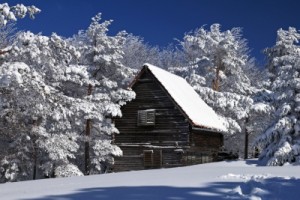Winter costs us money to heat our house. Over the last 14 years and at 3 different houses, we have heated our home using electric space heaters, a central electric heat pump, a whole house propane furnace, a wood fireplace, a whole house oil furnace and a fireplace propane gas log. The cost for these heat sources has varied widely. So has the hassle each entails. And here is what I have learned works best for us, in a 2-person house.
Regardless of the temperature you want to maintain in your house, I hope that you can save yourself a goodly amount of money by applying some of these non-rocket-science ideas.
The first thing I have learned is not to heat the whole house all the time. I am talking about a 3-bedroom-plus-extra-rooms house where only 2 people live. Most of the time we are in the same room; at worst, we are in 2 separate rooms. Why be heating the rest of the house? We do not.
So I therefore learned early on that whole-house central heating systems are not for me, regardless of what fuel they burn. No electric heat pump, no oil furnace, no propane furnace. Zone heating is the way to go for me. In my last house, that meant space heaters available for use in each room. In my present house, it means the individually controlled baseboard heaters found in each room.
We still need a background heat source, though, for the main core of the house (living room, kitchen, dining room). For this purpose, I found the choice of electricity, propane or wood as a fuel source to matter quite a bit in terms of cost.
Least expensive, of course, is wood; but I have found the required constant tending of a wood fire (and mess) to be unacceptable to me. Electricity as a heat source is flat-out wasteful: the power company is burning a fuel to generate heat that is used to produce electricity, which then arrives at one’s house so that it can be converted back to heat to warm the place up. Wasteful, wasteful! So I cut out the middleman by burning a fuel — propane — to directly heat the core of my house without any energy loss from conversion or transmission from outside (i.e. electricity) or transfer from inside the house (all types of central heating).
That means that we had a gas log installed in our fireplace and had it connected to the exterior propane tanks already there to fuel my back-up generator. The gas log cost $200 to buy and $200 to install. And it is AMAZING how much warmer the house core feels with the gas log set on “low” compared to what it felt like when we were using the central heat pump.
In fact, it is remarkable how much and for how long stored heat continues to radiate from the gas log fireplace bricks. Thanks to that residual heat radiation, we’ve found that it works very well for us to keep the gas log on until the thermostat in our central living room reaches 70 degrees Fahrenheit, then turn if off until that thermostat’s reading has dipped down to 63, then turn the gas log back on again, and “rinse and repeat.” (Remember too, that sweaters are your friends.)
Finally, when it is time to go to bed, we turn off the gas log and keep the bedroom warm with one of those baseboard heaters I mentioned earlier. And we sleep great, nicely snuggled under blankets. It all gives me a contented feeling. As does the money we save by heating our house this way.
# # #
image courtesy of adamr at FreeDigitalPhotos.net








Good ideas. Here in Arizona, we have the reverse issue: cooling. We’re home all day and spend most of our time in the living room (which extends into the dining room, which becomes the kitchen) so zone heating doesn’t much work. But we try to keep the temperature on the higher side (76-78) and we use the ceiling fans to boost the cooling effect.
It’s the best of a bad situation.
One of the first things we’ve ALWAYS done when moving into a new house is to install ceiling fans in any rooms not already having one. It’s a great tool to even out temperature. And it also works when you are trying to heat the house. (That’s what the fan’s directional toggle switch is for.)
Hey,
I unfortunately have electric heat but I’m in Houston and don’t need it often. On the (plus?) side, a ginormous tree fell on my house last year and I got lots of free firewood for the fireplace. I’m not burning now because it is warm enough with just a sweater. I want to get natural gas run to the house but am concerned it will be expensive to install.
Thanks for the blog post.
I imagine getting propane installed is different to natural gas installation. But, for us, a propane tanks + pipeline installation cost us less than $1000. We consider it a good investment.
Being from Minnesota, I know too well about heating costs. Wood is the fuel that heats twice…
I will be glad when that global warming finally appears. They have been talking about it for a long time, it’s still below zero here.
Thanks for commenting, No Nonsense.
I agree that wood is the most frugal heating fuel. I just wish I were more willing to do the work that’s involved to keep a wood fireplace or stove stoked, clean and operating properly.
Your heating story remind me of us; Years ago my wife continually complained about our cold kitchen. The plates would come out of the cabinets icy cold. Well we had a Stove/fireplace in town and I thought why not add a little heat back there. The kitchen and den are a large open space with a half wall between the rooms.
I spent about 5 grand for a Yotul gas stove with a wireless thermostat. That spring thanks to a bird that got into the oven vent, we discovered that the builder had not insulated the eves above the cabinets. We quickly remedied that situation. We also discovered that the stove is a joy. It not only heats the den and kitchen but the heat rises and keeps the bedrooms at sleeping temperature. The house boiler rarely comes on. Well my wife and son don’t love the PBS shows infancy so they usually stay up front watching their shows. They complained that I got to enjoy the warm of the stove more then them. So I returned to the fireplace/stove store and bought a slightly smaller Yotul (50%) for the front of the house. They love it
The heat is set to come on at 5:30 AM and when I come down the downstairs is delightfully toasty. Even on the coldest Pennsylvania morning. I have a recliner next to the stove and it’s my morning coffee and reading spot. In the end we heat where we live and we save – add triple pane windows and extra attic insulation and the cost is manageable
“We heat where we live” you said. ABSOLUTELY key.
We live in the UK and heating and electricity prices always seem astronomical. We have found that just heating were we live is the most economical solution, but we don’t heat the bedrooms!
We have loft and cavity wall insulation and double glazing so the house stays about 60 f throughout; then we just heat up whichever rooms we are using downstairs, which are usually the kitchen and living room. We also have an enclosed porch on the front and back doors which adds another layer of insulation to the house.
Today the external temperature was 48 f but the house was 60 f with no heating whatsoever when we came in. I was then cooking and baking and the house settled at 66 f, which we were very happy with because we had 2 jumpers each on plus thick socks and slippers.
We have a gas fire in the living room and an electric space heater in the kitchen, which is used very sparingly. The whole house gas central heating comes on very, very sparingly; as you say jumpers are good.
Our total gas and electricity is about £100 ($152) for the month including lighting and cooking and electrical gadgets.
You have a very good system set up. Congratulations!